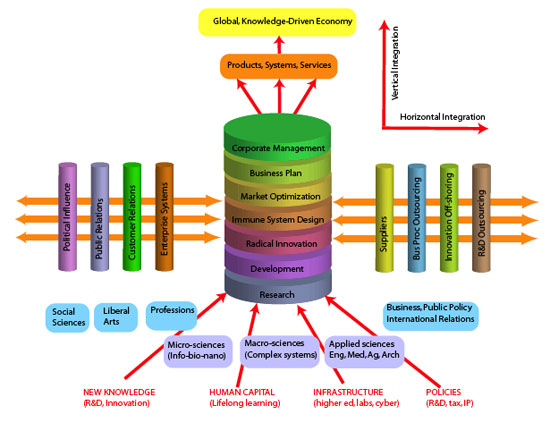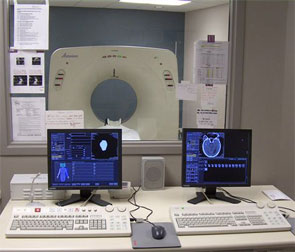| Posted: Jan 29, 2008 | |
The quiet crisis - the future of U.S. engineering, from nanotechnology to civil infrastructure |
|
|
(Nanowerk Spotlight) If you belong to the sizeable number of flag-waving, hand-on-the-bible type of Americans who believe that America has assumed it's god-given role as leader of the free world (if you don't live in this country, don't laugh; unfortunately this is not a joke) you probably haven't read Thomas L. Friedman's book 'The World Is Flat: A Brief History of the Twenty-first Century |
|
| In a chapter titled 'The Quiet Crisis' Friedman quotes Shirley Ann Jackson, the 2004 president of the American Association for the Advancement of Science and president of Rensselaer Polytechnic Institute since 1999: "The sky is not falling, nothing horrible is going to happen today" says Jackson. "The U.S. is still the leading engine for innovation in the world. It has the best graduate programs, the best scientific infrastructure, and the capital markets to exploit it. But there is a quiet crisis in U.S. science and technology that we have to wake up to. The U.S. today is in a truly global environment, and those competitor countries are not only wide awake, they are running a marathon while we are running sprints. If left unchecked, this could challenge our preeminence and capacity to innovate." | |
| A roadmap project on the future of engineering in the U.S. is coming pretty much to the same conclusion. The fundamental knowledge undergirding engineering practice increasingly requires research at the extremes, from nanotechnology to the mega level of global systems such as civil infrastructure, energy, and climate change as well as the mastery of new tools such as cyber infrastructure and quantum engineering. | |
| The report urges that this requires far greater attention by government and industry to the support of the long-term basic engineering research necessary to build the knowledge base key to addressing society’s needs. This is increasingly challenged both by the relentless pace of new technologies and their declining ability to attract a diverse cadre of the most capable students compared to other professional programs such as law, medicine, and business administration. | |
| When the U.S. enacted its 21st Century Nanotechnology Research and Development Act in 2003 it was clearly understood that the impact of nanotechnologies on all aspects of society would be deeply transformational. As the National Nanotechnology Initiative was set up, its goals were not only defined as "maintaining a world-class research and development program aimed at realizing the full potential of nanotechnology" but also to "facilitate transfer of new technologies into products for economic growth, jobs, and other public benefit." | |
| The first part regarding world-class R&D is happening. The second part, converting the R&D results into economic growth and jobs, is nowhere to be seen yet. It is certainly much more sexy to refer to exciting research results such as 'nanotube radios' or 'molecular walkers', just to take two of our news articles yesterday, then to talk about the role of educating the future generations of engineers that are required to transform the industrial base from today's macrotechnologies to tomorrow's nanotechnologies. Although talking about self-assembling is all the rage these days, these nanotube radios won't build themselves (at least not anytime soon). | |
| A strategic roadmapping exercise by the Millennium Project at the University of Michigan resulted in a 131-page report ("Engineering for a Changing World – A Roadmap to the Future of Engineering Practice, Research, and Education") that comes to the conclusion that the complex challenges facing the U.S. will require American engineers with a much higher level of education, particularly in professional skills such as innovation, entrepreneurship, and global engineering practice. | |
| In his book, Friedman quotes some astonishing trends from a National Science Board report: The number of American eighteen-to-twentyfour-years-olds who receive scientific degrees has fallen to seventeenth in the world, down from third place 30 years ago. The report said that of the 2.8 million first university degrees (bachelor's degrees) in science and engineering granted worldwide in 2003, 1.2 million were earned by Asian students in Asian universities, 830,000 were granted in Europe, and 400,000 in the United States. In engineering specifically, universities in Asian countries now produce eight times as many bachelor's degrees as in the United States. | |
| Moreover, the proportional emphasis on science and engineering is greater in Asian countries. Science and engineering degrees now represent 60 percent of all bachelor's degrees earned in China but only 31% in the United States. Factoring out science degrees, the number of Americans graduating with engineering degrees is 5 percent, compared to China's 46 percent. | |
| The UMichigan roadmap study reports similar trends: "In recent years there has been a growing concern about the supply of American engineers ...there has been a noticeable decline in student interest in careers in science and engineering over the past two decades. In the United States, baccalaureate engineering graduates dropped from 85,000 per year in 1985 to 61,000 in the mid-1990s, recovering only recently to 74,186. However there are new warning signs as undergraduate enrollments have now leveled off and begun to decline over the past three years from a peak of 373,000 students, with only 55% of those entering engineering programs eventually completing their degrees. There are concerns of a different nature at the graduate level. Although American universities graduated 39,015 masters degree students and 8,351 PhDs in 2006, masters degree enrollments peaked at 91,000 in 2003 and have declined to 83,000 in 2006, while PhD enrollments have leveled off at 57,000. Of more concern is the fact that today 40% of the engineering masters degree recipients and 61% of the new engineering PhDs in the United States are foreign nationals, raising the concern that students who are U.S. citizens show declining interest in graduate studies in engineering." | |
| It doesn't come as a complete surprise that in a country, where religious beliefs can trump scientific fact (some school boards have tried, and succeeded, in mandating the teaching of 'intelligent design' as a competing theory to evolution) there are increasing concerns that not all is well with its long-term scientific education. | |
| But while in the past the United States has compensated for its shortfall in scientists and engineers to a considerable degree by attracting talented students from around the world, the post 9/11 constraints on immigration policies and an increasingly cynical view of American foreign policy have cut deeply into the flow of international students into U.S. universities and industry. | |
| The roadmap study points out that this situation is compounded by "our nation’s inability to address the relatively low participation of women and underrepresented ethnic minorities in science and engineering. Today nearly two-thirds of today’s engineering students who are U.S. citizens are white males, at a time when the largest growth in our workforce over the next decade will come from women and underrepresented minorities. | |
| "More specifically, while women account for 47% of the American workforce, they represent only 9% of engineers. Furthermore, women students comprise 56% of college enrollments and receive 60% of college degrees, yet account for only 20% of engineering degrees and 11% of engineering faculty. The situation is even more alarming for underrepresented minorities, with African American and Hispanic American engineering enrollments remaining below 5% and 6%, respectively, and engineering faculty participation at 2.4%, although comprising 13.4% and 14.5% of the American population in 2005." | |
| As presidential science advisor John Marburger concluded: "The future strength of the U.S. science and engineering workforce is imperiled by two long-term trends: First the global competition for science and engineering talent is intensifying, such that the U.S. may not be able to rely on the international science and engineering labor market for its unmet skill needs. Second, the number of native-born science and engineering graduates entering the workforce is likely to decline unless the nation intervenes to improve success in educating science and engineering students from all demographic groups, especially those that have been underrepresented in science and engineering careers." | |
 |
|
| 21st Century Engineering (Source: "Engineering for a Changing World – A Roadmap to the Future of Engineering Practice, Research, and Education", University of Michigan) | |
| One of the key observations of the roadmap study is that tomorrow's engineers will spend most of their careers coping with challenges and opportunities vastly different from those most currently practicing engineers – or currently teaching faculty – have experienced. Future technology trends will be marked not only by accelerating advancements in individual technologies but also by a force-multiplying convergence of the technologies – information, biological, materials, and nanotechnologies – that have the potential to revolutionize all dimensions of life. | |
| From the report: "Engineering research is evolving along two trajectories. One frontier is characterized by smaller and smaller sizes and faster and faster time scales – the world of info-, bio-, and nanotechnology. Here the physical sciences, life science, and information sciences are converging, creating disruptive technologies that evolve exponentially (Moore’s law). Working at this level requires engineers to master new forms of engineering science based on disciplines such as quantum mechanics, genomics and proteomics, and abstract mathematics. | |
| At the other extreme are larger and larger systems of great complexity such as energy, environment, infrastructure, urban systems, and global systems – addressing some of the most daunting challenges to our future survival. While academic research continues to lead the way in the engineering sciences characterizing microscopic technology, the engineering research needed to address large-scale systems has traditionally been the focus of industry and government." | |
| To understand better the skills and competencies required for 21st-century engineers, consider the possible careers for engineers: | |
|
|
|
| In particular it seems that three competencies will be important for tomorrow's engineers: | |
| The ability to innovate – the capacity to produce concurrent discovery and innovation, key to both economic prosperity and social well being in a knowledge driven world; | |
| The ability to integrate knowledge across an increasingly broad intellectual span from many different fields; and | |
| A global perspective – the capacity to work in multidisciplinary teams characterized by high cultural diversity, while exhibiting the nimbleness and mobility to address rapidly changing global challenges and opportunities. | |
| What makes preparing for the future so difficult is that, in a world where the science and engineering knowledge base is growing at an exponential pace, it is impossible to predict it. In such fields such as nanotechnology, the knowledge doubling time is as short as five years, making a student's education obsolete even before graduation. | |
  |
|
| The Times They Are A-Changin' – medicine in 1900 and in 2000 | |
| Cautioning that predicting the future is a tricky undertaking, the roadmap study concludes that "despite this explosion of new knowledge, we frequently overestimate the near-term impact of technological change, while greatly under estimating its impact over the longer term. Part of the reason is that we tend to extrapolate what we know today to predict a future that may be dramatically different than we can imagine because of disruptive technologies. | |
| "But predicting future trends in engineering and technology is hazardous for another reason. The near-term impact of engineering is usually constrained by the rate of social change, since technological change occurs with a social, economic, and political context. However, once technology begins to reshape culture, e.g., the Internet or wireless communication, society can change very significantly. Here it is important to recognize that the technologies – info-bio-nano – that are driving such disruptive change are characterized by exponential evolution, increasing in power by 100 to 1,000 fold each decade. If these technologies continue to evolve at this pace over the next several decades almost any imagined future is possible, as well as some we cannot even imagine." | |
 By
Michael
Berger
– Michael is author of three books by the Royal Society of Chemistry:
Nano-Society: Pushing the Boundaries of Technology,
Nanotechnology: The Future is Tiny, and
Nanoengineering: The Skills and Tools Making Technology Invisible
Copyright ©
Nanowerk LLC
By
Michael
Berger
– Michael is author of three books by the Royal Society of Chemistry:
Nano-Society: Pushing the Boundaries of Technology,
Nanotechnology: The Future is Tiny, and
Nanoengineering: The Skills and Tools Making Technology Invisible
Copyright ©
Nanowerk LLC
|
Become a Spotlight guest author! Join our large and growing group of guest contributors. Have you just published a scientific paper or have other exciting developments to share with the nanotechnology community? Here is how to publish on nanowerk.com.
